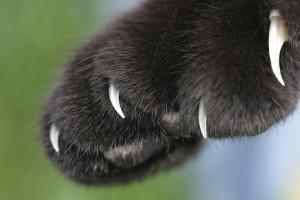Paw Problems Explained…
 Cat paw problems are unfortunately common, but some owners are daunted by the thought of getting close to a cat’s feet – they have sharp bits and aren’t afraid to use them. However, the benefits to learning the technique of trimming of cats’ claws are enormous and well worth the effort for both owner and cat.
Cat paw problems are unfortunately common, but some owners are daunted by the thought of getting close to a cat’s feet – they have sharp bits and aren’t afraid to use them. However, the benefits to learning the technique of trimming of cats’ claws are enormous and well worth the effort for both owner and cat.
Regular trimming of cats’ claws keeps the nails healthy, makes the cat easier to handle and allows health problems to be identified early.
With a kitty pedi your cat will be able to shed the old outer layers of the claw more easily, and prevent its claws getting so long they damage the foot pads – particularly for indoor and seniors who cannot wear down their claws as easily.
Cats who have been trained to have their claws trimmed are less concerned when their legs and rest of their body is examined. Feet are very sensitive and if a cat trusts you with their feet, they will trust you to handle most parts.
Sadly though, don’t think this will save the couch. Cats who have had their claws trimmed are still able to exhibit natural scratching behaviour and still need scratching posts. Scratching on furniture will not be prevented by trimming. Behavioural strategies and claw covers can be implemented if it really is a problem. Starting early will mean there is less damage to be managed – two kittens and a scratching post keep their mental health and your belongings in better shape.
When Claws Show Clues to illness or injury!
Symptoms of sad paws and claws can include:
- Lots of paw licking
- Trouble walking
- Pain
- Swelling, redness or bleeding around the nails and footpads
- Lumps or ulcers where the nails start, on the top of the paws, or even on the footpads
- Smelly feet
- Strange nail colour – such as blackened coating common with Malassezia fungal infection
- Loss of hair from the top of the feet
- Dry, scaly or cracked foot pads or skin
- Objects embedded in between the toes or in the footpad
Why Is My Cat’s Paw Sore?
Diseases and illness specifically affecting cat’s feet include:
- Fungal infections such as Malassezia are common and have a distinctive black dirty appearance.
- Allergic reactions to pollen, mould and insect bites are also seen frequently. In severe cases this can cause blistering, ulceration, redness of the skin and and in severe cases, hard raised lumps (eosinophillic granuloma complex).
- Arthritis affects cats of all ages and is sadly often missed. In addition to progressive joint disease, arthritis is associated with caliciviris, diabetes mellitus and bacterial infection can also trigger arthritis. The cat will have thickened nails, pain, swelling and possibly redness.
- Cats can get tumours or cancer on their paws or on their nail beds. These are most often spread from other cancers around the body.
- Objects that get stuck in paws can become infected if not removed. Sometimes allergy can lead the cat to injure their own skin from lots of grooming.
- Ringworm is common in kittens but rare in older cats, and is as easily caught from playing in the garden as from other cats. In cats it just looks like dry red skin.
- Bacterial infections can occur when there has been an injury or other disease. Bacteria that occur naturally on skin are much more common (Staphylococcus, Streptococcus). Bacteria from the environment are more rare or require special conditions to grow (Nocardia, Pseudomonas, Mycobacteria).
- Sometimes the cat’s immune system can also trigger an overly strong response resulting in the body attacking itself in a similar way to a severe allergic response. This can cause blistering, pustules and dry, scaly skin, most commonly of the head, ears and footpads. Forms of this that affect cat feet are called Pemphigus foliaceus, Pemphigus erythematosus or Pemphigus vulgaris.
- Pillow foot (Plasma cell pododermatitis) is a rare disease that causes swelling, softness and sometimes ulceration of the foot pads. It affects cats of all breeds and ages.
- Mites such as Sarcoptes and Demodex are more rare in cats but shouldn’t be forgotten. They cause irritated itchy skin or little pimples and ‘mange’.
- Excess growth hormone can change the bone structure of affected cats giving paws an enlarged club-shaped appearance, but are only a problem if the cat is in pain.
When To Start Trimming Your Cat’s Claws To Get Paw Purrfection
Training your cat to have its claws trimmed is best started early as a kitten, but can be commenced with care at any time.

